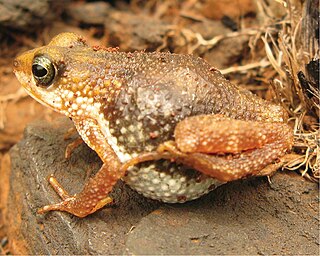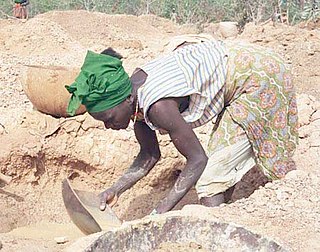
Transport in Guinea is composed by a variety of systems that people in the country use to get around as well as to and from domestic and international destinations.

Transport in Liberia consist of railways, highways, seaports and airports.

Mount Richard-Molard, also known as Mount Nimba, is a mountain along the border of Ivory Coast and Guinea in West Africa. The highest peak for both countries and the Nimba Range is at 1,752 m (5,748 ft). The mountain is a part of the Guinea Highlands, which straddles the borders between the two countries and Liberia. The nearest major settlements are the town Yekepa to the west in Liberia, Bossou and N'Zoo in Guinea.

Guinée forestière is a forested mountainous region in southeastern Guinea, extending into northeastern Sierra Leone. It is one of four natural regions into which Guinea is divided and covers 23% of the country. It includes all of the Nzérékoré administrative region.

Nimba County is a county in the northeastern Liberia that shares borders with the Republic of Côte d'Ivoire in the East and the Republic of Guinea in the Northwest. Its capitol city is Sanniquellie and its most populous city is Ganta. With the county's area measuring 11,551 square kilometres (4,460 sq mi), Nimba is the largest of Liberia's 15 counties. The county has 6 statutory districts and as of the 2008 Census, it had a population of 462,026, making it the second most populous county in Liberia.

Mount Nimba Strict Nature Reserve is a protected area and UNESCO World Heritage Site located in both Guinea and Côte d'Ivoire, extending over a total of area of 17,540 hectares, with 12,540 hectares in Guinea, and 5,000 hectares in Côte d'Ivoire. The reserve covers significant portions of the Nimba Range, a geographically unique area with unusually rich flora and fauna, including exceptional numbers of single-site endemic species, such as viviparous toads, and horseshoe bats. Its highest peak is Mount Richard-Molard at 1,752 m (5,750 ft), which is the highest peak of both countries.
Articles related to Guinea include:
Iron ore production in Africa is dominated by South Africa, Mauritania and Algeria; Zimbabwe and Morocco produce ore for use within the country. Many countries possess iron ore deposits that are as yet untapped/unmined. Countries and companies currently involved in production are listed here; measurements are in tpy, or tonnes per year.
The Liberian-American-Swedish Mining Company (LAMCO) is a defunct Liberian corporation that mined for iron ore in the Nimba range in Liberia. Founded in 1955 by American and Swedish investors, the company established the first large-scale mining operation in Liberia following the discovery of the Nimba ore body by geologist Sandy Clarke in the 1950s. A standard gauge railroad approximately 360 km long was built, linking the mine in the north of the country, to the Port of Buchanan. The Nimba project was managed by LAMCO, Bethlehem Steel and the Liberian government. A nationalization policy was introduced to gradually phase out the non-Liberian staff. In November 1989, LAMCO was taken over by LIMINCO and under a ten-year contract managed by AMCL. Operations were disrupted, but never damaged, several times beginning in September 1990, and were halted in January 1994 when ships were no longer willing to pick up ore at the Port of Buchanan. Soon after operations were halted, LIMINCO's sites at Yekepa and Buchanan were pillaged which continued until 2004. Today, the former LAMCO mining operation is being reactivated by Arcelor Mittal.

Lamotte's roundleaf bat is a species of bat found only at Mount Nimba on the border of Côte d'Ivoire, Guinea and Liberia. It is critically endangered.

Nimbaphrynoides is a monotypic genus of true toads from highlands in the Mount Nimba region of the West African countries of Guinea, Liberia, and Côte d'Ivoire. The sole species is Nimbaphrynoides occidentalis. Along with Nectophrynoides, Eleutherodactylus jasperi, and Limnonectes larvaepartus, Nimbaphrynoides are the only frogs/toads that do not lay eggs.
Railway stations in Guinea include:

Railways in Liberia comprised two lines from the port of Monrovia in the northeast, and one line from the port of Buchanan in the centre. The principal traffic is, or was, iron ore. In 2010, only the Bong mine railway was operational but the Lamco Railway was at least partially rebuilt by Arcelor Mittal and put back into service in 2011.

The Guinean montane forests are a tropical moist broadleaf forest ecoregion of West Africa
The Kalia mine is a large iron mine located in central Guinea in the Faranah Region. Kalia represents one of the largest iron ore reserves in Guinea and in the world having estimated reserves of 6.16 billion tonnes of ore grading 54.1% iron metal.

The mining industry of Guinea was developed during colonial rule. The minerals extracted consisted of iron, gold, diamond, and bauxite. Guinea ranks first in the world in bauxite reserves and 6th in the extraction of high-grade bauxite, the aluminium ore. The mining industry and exports of mining products accounted for 17% of Guinea’s gross domestic product (GDP) in 2010. Mining accounts for over 50% of its exports. The country accounts for 94% of Africa’s mining production of bauxite. The large mineral reserve, which has mostly remained untapped, is of immense interest for international firms.

The mining industry of Liberia has witnessed a revival after the civil war which ended in 2003. Gold, diamonds, and iron ore form the core minerals of the mining sector with a new Mineral Development Policy and Mining Code being put in place to attract foreign investments. In 2013, the mineral sector accounted for 11% of GDP in the country and the World Bank has projected a further increase in the sector by 2017.

The Nimba Range forms part of the southern extent of the Guinea Highlands. The highest peak is Mount Richard-Molard on the border of Côte d'Ivoire and Guinea, at 1,752 m (5,750 ft). "Mount Nimba" may refer either to Mount Richard-Molard or to the entire range. Other peaks include Grand Rochers at 1694 m (5558 ft), Mont Sempéré at 1682 m (5518 ft), Mont Piérré Richaud at 1670 m (5479 ft), Mont Tô at 1675 m (5495 ft), and Mont LeClerc 1577 m (5174 ft), all of them are located in Guinea. Mount Nimba Strict Nature Reserve of Guinea and Côte d'Ivoire covers significant portions of the Nimba Range.
The Lachaise's climbing mouse is a species of climbing mouse described by Denys and Aniskine in 2012. First discovered on the slopes of Mount Nimba, it is now believed that the species is extant within Guinea, Liberia and Cote d’Ivoire.
The geology of Liberia is largely extremely ancient rock formed between 3.5 billion and 541 million years ago in the Archean and the Neoproterozoic, with some rocks from the past 145 million years near the coast. The country has rich iron resources as well as some diamonds, gold and other minerals in ancient sediment formations weathered to higher concentrations by tropical rainfall.














